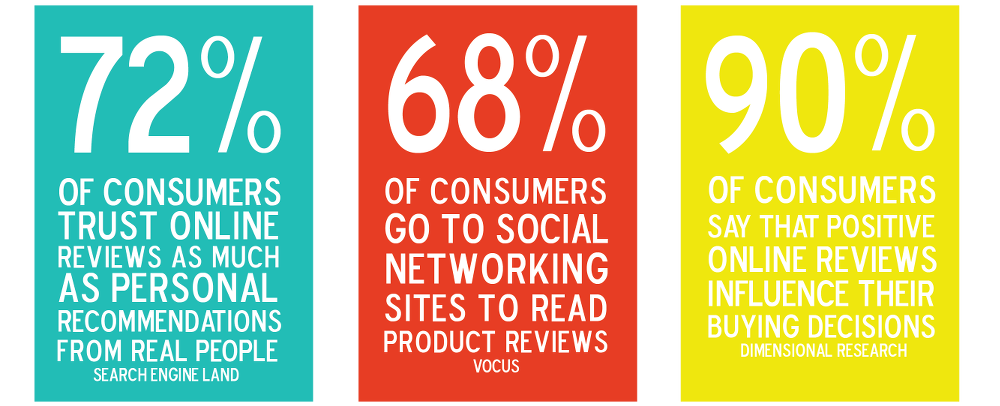In my previous blog post (Will allowing your customers to post reviews on your website make or break your reputation as a business?), I spoke about the advantages and disadvantages of using an online review system within your business and how you can effectively manage them. Having an online review system can boost your business’s reputation as customers can see that you are transparent and trustworthy. However, it is vital that you know how to successfully operate and manage your review system so that it works as it intends to. This blog post aims to guide you, as a business, on how to successfully run an online review system as well as provide examples of businesses who have the right idea when it comes to their review systems and outline any potential risks that may come along the way.
Research by Idig Marketing (2017) shows that online reviews are critical for a business, as consumers increasingly rely on them to guide their decision-making. Positive reviews can increase sales and build trust for your brand, while negative reviews can scare off potential customers and chip away at your brand’s reputation (Idig marketing, 2017).

Tips for a Successful Review System
As we have previously established, an online review system can boost your business’s reputation but only if it is managed in the right way and used for the right reasons.

Below are some useful tips that can be used when running your online review system successfully.
- Respond to every review – Most business owners get scared of negative reviews, and avoid looking at them, but you should always respond to reviews, especially when they are negative (Rayome, 2017). When people see a company engaging with their reviews, it shows that they care and want to fix any issues that have come up.
- Proactively request feedback – There are was to put leaving a review at the top of someone’s mind without being pushy (Davis, 2017). You can get customers to leave a review through the experience you have provided and let customers know how and where they can leave a review if they want to.
- Be professional – Do not argue with someone because they have left a negative review. Wherever possible, figure out a solution to the problem and offer a remedy, not an explanation. Ensure your responses are varied and do not all say the same thing.
- Maintain a high frequency of reviews – When customers see a lot of reviews, it gives them the idea that your business is popular and is trusted by customers.
The following video gives you information on how you can reply to both good and bad reviews:
Check out this article with 19 strategies to get more feedback: http://blog.clientheartbeat.com/customer-feedback/
Potential Risks
There are many risks that come with having an online review system and it is important to know how to handle these risks effectively and stop them from happening in the future. The following risks are the ones you should look out for the most and do everything to stop it from happening.
- Negative reviews can ruin your reputation, especially if they’re not handled well. Promoting the practice of leaving reviews is taking a big risk as you have no idea what may come your way and what people have to say. The best way to deal with a negative review is to respond professionally and aim to fix the problem.
- There is a chance you will get fake reviews being posted onto your website. These may be from competitors or just a person with too much time on their hands. This is why it is important to have someone monitor your reviews always so that potential fake reviews can be removed.
- You may want to post a fake positive review yourself, DO NOT DO THIS. This is also known as ‘astroturfing’ and could get you in serious trouble. You could be prosecuted and fined.
- Quite possibly the biggest risk is how much your potential customers rely on reviews when making a purchase decision. Chatterjee (2001) backs this up by saying ‘Consumers choosing an unfamiliar retailer because of a lower price seek more
negative WOM information, and are more likely to believe that the problems may
recur compared to consumers patronising a firm they are familiar with.’
Allowing customers to post reviews can be a scary prospect for your business, but can actually be a very strong marketing tool. Reviews can bring in more customers but you must remember to manage and monitor your online reviews frequently and aim to fix any issues that have been bought up in reviews. There is also always potential risks associated with online reviews that need to be looked out for always.
Check out this website that gives 8 examples of businesses responding to reviews: https://www.reviewtrackers.com/examples-responding-reviews/
References
Chatterjee, P. (2001) Online Reviews: Do Consumers Use Them? Association for Consumer Research, P129-134.
Davis, A. (2017) 10 Quick Tips for Managing Online Reviews. [Online] Available at: https://www.nationaljeweler.com/independents/ecommerce/5997-ten-quick-tips-for-managing-online-reviews [Accessed 5th April 2018].
Idigmarketing. (2017) Online Reviews Part 1: Importance and Overview of Review Sites. [Online] Available at: http://idigmarketing.com/blog/2017/03/23/importance-online-review/ [Accessed 5th April 2018].
Rayome, A. (2017) 7 Best Practices for Managing Online Reviews of your business. [Online] Available at: https://www.techrepublic.com/article/7-best-practices-for-managing-online-reviews-of-your-business/ [Accessed 5th April 2018].









